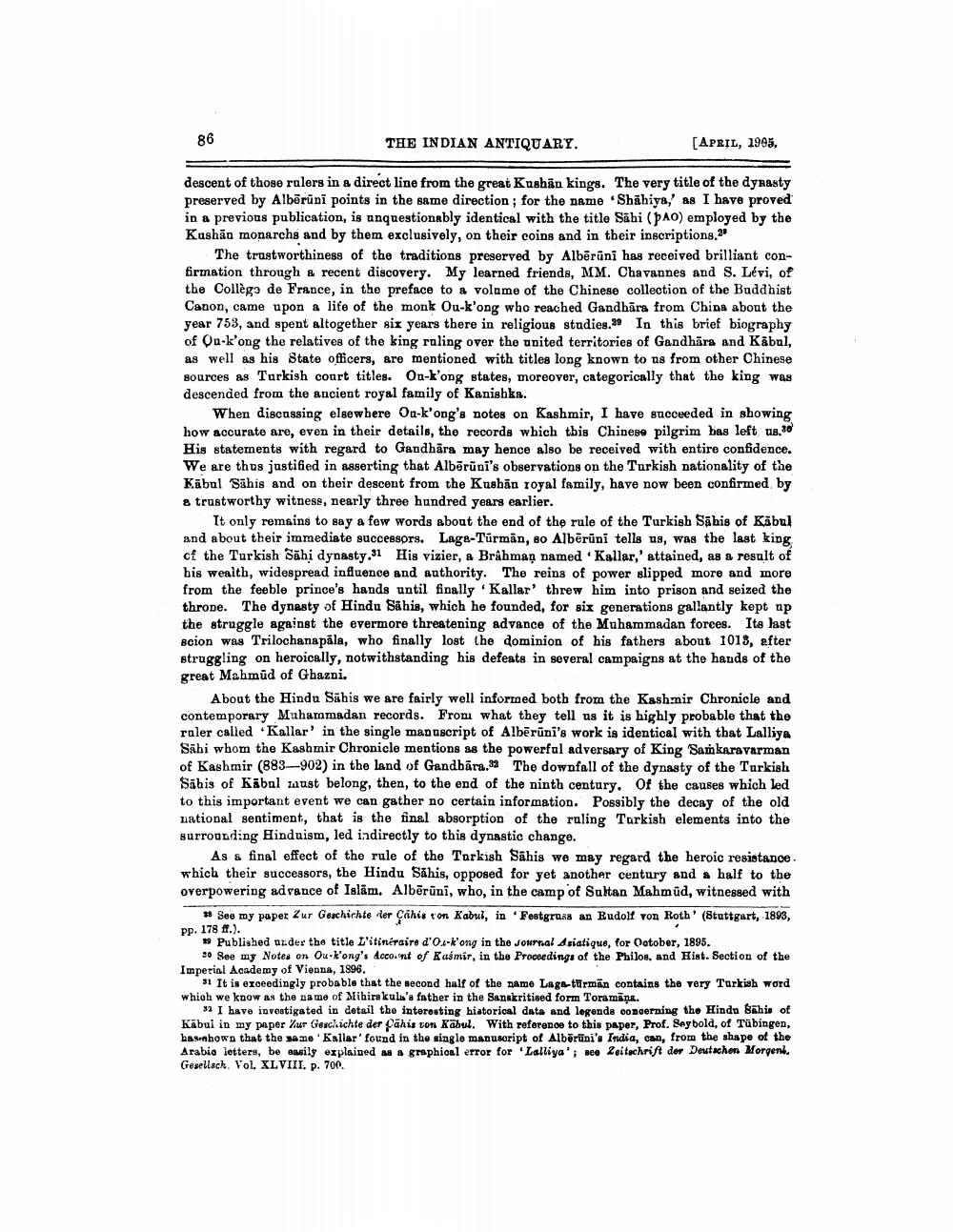________________
THE INDIAN ANTIQUARY
[APRIL, 1905,
descent of those rulers in a direct line from the great Kushän kings. The very title of the dynasty preserved by Albērūni points in the same direction; for the name "Shāhiya,' as I have proved in a previous publication, is anquestionably identical with the title Sāhi (PAO) employed by the Kushān monarchs and by them exclusively, on their coins and in their inscriptions.3
The trustworthiness of the traditions preserved by Albērūni has received brilliant confirmation through a recent discovery. My learned friends, MM. Chavannes and S. Lévi, of the Collège de France, in the preface to a volume of the Chinese collection of the Buddhist Canon, came upon a life of the monk Ou-k'ong who reached Gandhāra from China about the year 753, and spent altogether six years there in religious studies.30 In this brief biography of Qu-k'ong the relatives of the king ruling over the united territories of Gandhāra and Kabul, as well as his State officers, are mentioned with titles long known to us from other Chinese sources as Turkish court titles. On-k'ong states, moreover, categorically that the king was descended from the ancient royal family of Kanishka.
When discussing elsewhere On-k'ong's notes on Kashmir, I have succeeded in showing how accurate are, even in their details, the records which this Chinese pilgrim has left us.30 His statements with regard to Gandhāra may hence also be received with entire confidence. We are thus justified in asserting that Albērüni's observations on the Turkish nationality of the Kabul Sāhis and on their descent from the Kushān royal family, have now been confirmed by 8 trustworthy witness, nearly three hundred years earlier.
It only remains to say a few words about the end of the rule of the Turkish Sāhis of Kabul and about their immediate successors. Laga-Türman, 8o Albērūni tells us, was the last king of the Turkish Sāhị dynasty,31 His vizier, a Brahman named Kallar,' attained, as a result of his wealth, widespread influence and authority. The reins of power slipped more and more from the feeble prince's hands until finally Kallar' threw him into prison and seized the thrope. The dynasty of Hindu Sāhis, which he founded, for six generations gallantly kept up the struggle against the evermore threatening advance of the Muhammadan forees. Its last scion was Trilochanapāla, who finally lost the dominion of his fathers about 1013, after struggling on heroically, notwithstanding his defeats in several campaigns at the hands of the great Mahmud of Ghazni.
About the Hindu Sähis we are fairly well informed both from the Kashmir Chronicle and contemporary Muhammadan records. From what they tell us it is highly probable that the ruler called Kallar' in the single manuscript of Albērüni's work is identical with that Lalliya Sāhi whom the Kashmir Chronicle mentions as the powerful adversary of King Samkaravarman of Kashmir (883-902) in the land of Gandbāra.32 The downfall of the dynasty of the Turkish Säbis of Käbal zaust belong, then, to the end of the ninth century. Of the causes which led to this important event we can gather no certain information. Possibly the decay of the old national sentiment, that is the final absorption of the ruling Turkish elements into the surrounding Hinduism, led indirectly to this dynastic change.
As a final effect of the rule of the Turkish Sāhis we may regard the heroic resistance. which their successors, the Hindu Sāhis, opposed for yet another century and a half to the overpowering advance of Islām. Albērūni, who, in the camp of Sultan Mahmud, witnessed with
18 See my paper Zur Geschichte der Cahis con Kabul, in Festgruas an Rudolf von Roth' (Stuttgart, 1893, pp. 178 .).
# Published under the title L'itinéraire d'Ou-k'ong in the Journal Asiatique, for October, 1895.
30 See my Notes on Ou-k'ong's Account of Kašmir, in the Proceedings of the Philos. and Hist. Section of the Imperial Academy of Vienna, 1896.
31 It is exceedingly probable that the second half of the name Laga turman contains the very Turkish word which we know as the name of Mihira kula's father in the Sanskritised form Toramāņa.
I have investigated in detail the interesting hiatorical data and legends concerning the Hindu Bahis of kābui in my paper lur Geschichte der Cāhis son Kabul. With reference to this paper, Prof. Seybold, of Tübingen, basenhown that the same 'Kallar' found in the single manuscript of Albērūni's India, can, from the shape of the Arabio letters, be easily explained as a graphical error for Lalliya'; see Zeitschrift der Deutschen Morgenb. Gesellsck. Vol. XLVIII. p. 700.




